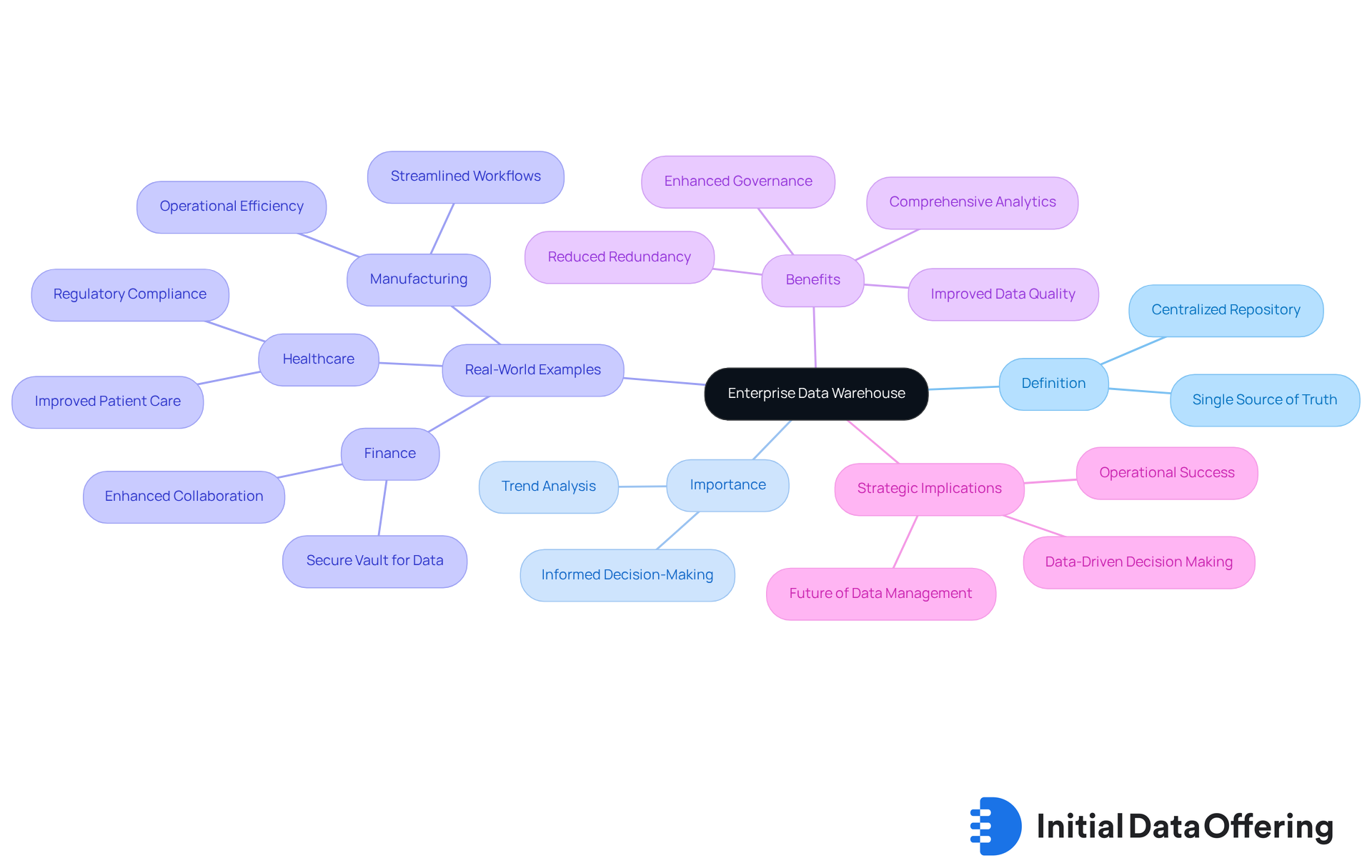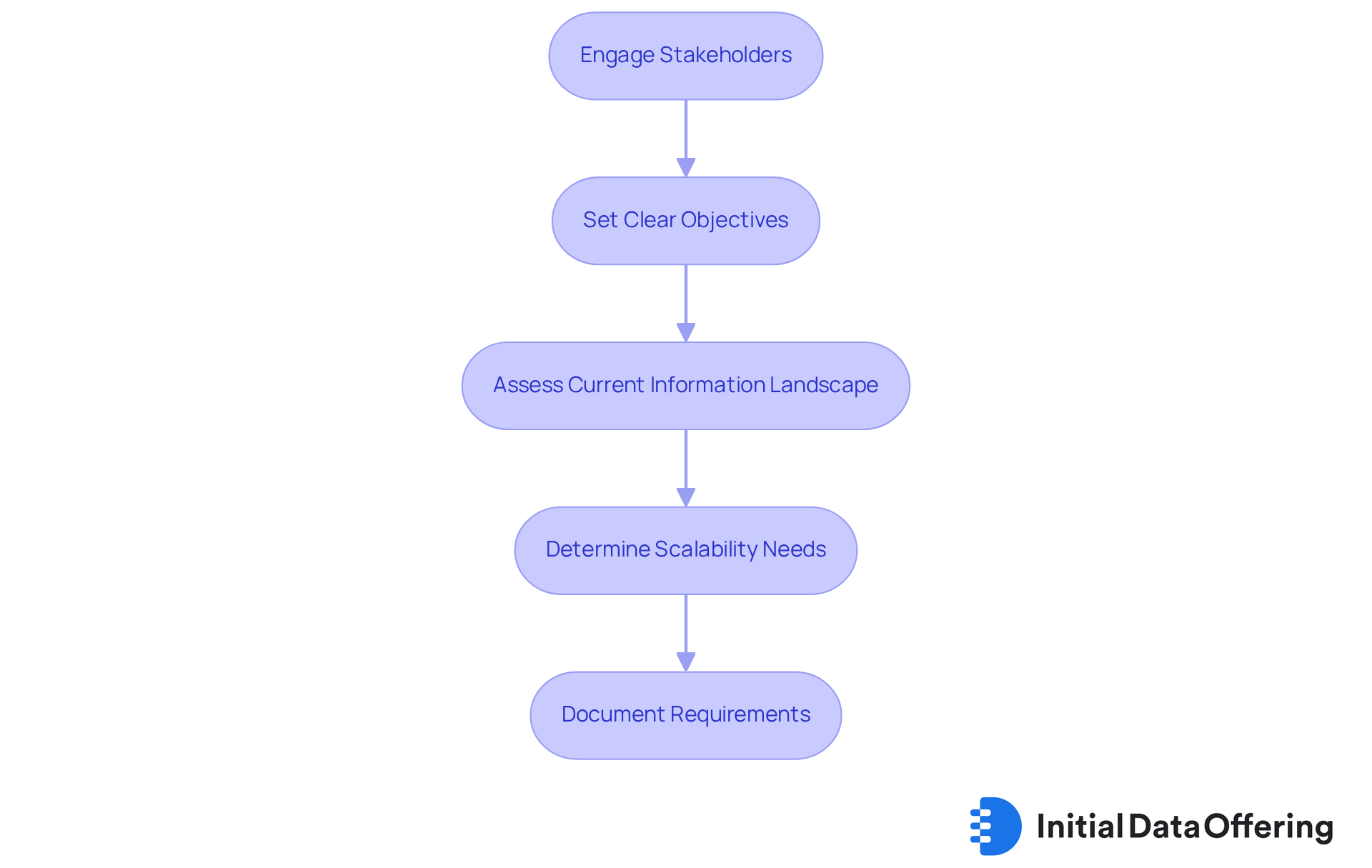Define Your Enterprise Data Warehouse: Key Steps for Success

Define Your Enterprise Data Warehouse: Key Steps for Success
Overview
This article outlines essential steps for successfully defining an Enterprise Data Warehouse (EDW). It emphasizes the importance of integrating diverse information sources, establishing clear objectives, and implementing data governance standards.
-
Why is this important? These steps are crucial as they ensure that the EDW meets organizational needs. By integrating various data sources, organizations can enhance operational efficiency. This integration not only streamlines processes but also improves decision-making through reliable and accessible data.
-
Consider how your organization currently manages data. Are there gaps in integration? Establishing clear objectives can guide the development of your EDW, ensuring it aligns with your strategic goals. Implementing data governance standards further solidifies the integrity and security of your data, fostering trust among stakeholders.
In conclusion, a well-defined EDW can significantly impact your organization’s performance. By focusing on these key steps, you can create a robust framework that supports informed decision-making and drives success.
Introduction
Defining an Enterprise Data Warehouse (EDW) goes beyond mere technicalities; it signifies a crucial transformation in how organizations handle and leverage their data. As information landscapes grow increasingly complex, businesses are beginning to appreciate the importance of a centralized repository. This repository not only consolidates data but also significantly enhances decision-making and operational efficiency.
However, the path to a successful EDW implementation is not without its challenges. How can organizations ensure that their EDW is defined in a manner that genuinely aligns with their strategic objectives? This article explores the essential steps and considerations necessary for creating a robust EDW that not only drives informed decision-making but also promotes organizational growth.
Understand the Concept of Enterprise Data Warehouse
To define enterprise data warehouse, it is important to note that an Enterprise Data Warehouse (EDW) serves as a centralized repository that consolidates information from various sources within an organization, creating a single source of truth. This integration allows businesses to conduct thorough information analysis and reporting, which facilitates informed decision-making. To define enterprise data warehouse, it is a system that brings together organized information from different operational systems, ensuring that all relevant details are readily available for strategic insights and operational efficiency.
The importance of centralized information repositories is underscored by the fact that a significant percentage of organizations now utilize them for decision-making. This enhances their ability to analyze trends and make informed choices. Experts in information management emphasize that to define enterprise data warehouse (EDW) properly is crucial, as it not only simplifies access to information but also improves quality and consistency—both of which are essential for effective analysis.
Real-world examples highlight the impactful role of EDWs. Companies that have adopted centralized information repositories report better operational efficiency and enhanced collaboration across departments. In finance, a central information repository functions as a secure vault for sensitive data, promoting compliance and inter-departmental cooperation. Similarly, in healthcare, centralized information repositories enhance patient care by consolidating various details, leading to improved diagnoses and adherence to regulatory standards.
The benefits of a centralized information repository extend beyond mere data storage; they include enhanced governance, reduced redundancy, and the ability to conduct comprehensive analytics. As organizations increasingly recognize the importance of centralized information management, it is essential to define enterprise data warehouse, as its role in driving strategic planning and operational success becomes increasingly vital.
How can your organization leverage an EDW to improve decision-making and operational efficiency? Consider the transformative potential of centralized information management in your strategic initiatives.

Identify Key Components of an Enterprise Data Warehouse
To define enterprise data warehouse, it is important to understand that the key components are essential for organizations looking to leverage their data effectively. Understanding these components can significantly enhance the design and functionality of an EDW, ensuring it meets organizational needs.
-
Information Sources: The EDW integrates various internal and external information sources, such as operational databases, CRM systems, and third-party information feeds. This diversity allows organizations to gather comprehensive data, providing a holistic view of their operations.
-
ETL Processes: Extract, Transform, Load (ETL) tools play a crucial role in transferring information from source systems into the EDW. These processes ensure that the data is cleaned and formatted appropriately, which enhances its reliability and usability. How might your organization benefit from streamlined ETL processes?
-
Information Storage: A robust storage solution is vital for managing large quantities of information. Organizations often utilize cloud-based or on-premises databases to ensure scalability and accessibility. This flexibility allows for efficient data management and retrieval.
-
Access Layer: The access layer comprises tools and interfaces that enable users to query and analyze information effectively. Business Intelligence (BI) tools and reporting software empower users to derive insights from the data, facilitating informed decision-making.
-
Metadata Management: Effective metadata management systems oversee information definitions, lineage, and quality metrics. This oversight is crucial for maintaining data integrity and usability, ensuring that users can trust the information they are working with.
By understanding these components, organizations can define enterprise data warehouse solutions that not only meet their current needs but also adapt to future challenges.

Define Your Enterprise Data Warehouse Objectives and Requirements
To define your Enterprise Data Warehouse (EDW) objectives and requirements, consider the following steps:
-
Engage Stakeholders: Collaborating with key stakeholders across departments is crucial. This engagement helps gather insights on their information requirements and expectations, ensuring that the EDW aligns with organizational needs.
-
Set Clear Objectives: Establish specific, measurable goals for the EDW. For instance, you might aim to improve reporting accuracy, enhance information accessibility, or support advanced analytics. These objectives provide a clear direction for the project.
-
Assess Current Information Landscape: Evaluate existing information sources, systems, and processes. This assessment allows you to identify gaps and opportunities for integration, which is essential for a successful EDW.
-
Determine Scalability Needs: Consider future growth and scalability requirements. Ensuring that the EDW can accommodate increasing information volumes and user demands is vital for long-term success.
-
Document Requirements: Create a comprehensive requirements document. This document should outline technical specifications, user access needs, and compliance considerations, serving as a roadmap for the EDW development.
By clearly defining objectives and requirements, organizations can ensure they define enterprise data warehouse solutions that are tailored to support strategic initiatives and enhance operational efficiency. How might these steps apply to your organization? Consider the potential benefits of a well-defined EDW in streamlining processes and improving decision-making.

Establish Data Governance and Quality Standards
To establish data governance and quality standards for your Enterprise Data Warehouse (EDW), follow these essential steps:
-
Define Governance Framework: Start by developing a governance framework that clearly outlines roles, responsibilities, and processes for managing information throughout its lifecycle. This framework serves as the backbone of your data governance strategy, ensuring everyone understands their part in maintaining data integrity.
-
Implement Information Integrity Metrics: Next, establish metrics to evaluate key dimensions of information integrity, such as accuracy, completeness, consistency, and timeliness. By measuring these aspects, you can gain insights into the quality of your data and identify areas needing improvement.
-
Establish Stewardship Roles: Designate stewards who will be accountable for managing information integrity within specific domains or departments. These individuals play a crucial role in ensuring adherence to governance standards and fostering a culture of data responsibility.
-
Establish Information Policies: Create comprehensive policies that govern access, usage, and security of sensitive information. These policies not only protect your data but also ensure compliance with relevant regulations, safeguarding your organization against potential risks.
-
Routine Audits and Assessments: Finally, perform routine audits and assessments of your information integrity and governance practices. This ongoing evaluation helps pinpoint areas for enhancement and ensures compliance with established standards, ultimately strengthening your data governance framework.
To define enterprise data warehouse, organizations can significantly enhance reliability by implementing robust data governance and quality standards. This leads to improved decision-making and more strategic outcomes, empowering teams to leverage data effectively in their operations.

Conclusion
Defining an Enterprise Data Warehouse (EDW) is crucial for organizations that want to harness their data effectively. At its core, an EDW acts as a centralized repository, integrating information from various sources. This integration enables comprehensive analysis and informed decision-making. By establishing a single source of truth, businesses can enhance operational efficiency and promote collaboration across departments, ultimately leading to strategic success.
Key components of an EDW include:
- Information sources
- ETL processes
- Storage solutions
- Access layers
These elements are vital for the functionality of the warehouse. Additionally, having clearly defined objectives and robust data governance frameworks ensures that the EDW meets current needs while remaining adaptable for future challenges. This structured approach allows organizations to improve data quality, enhance compliance, and foster a culture of data responsibility.
Organizations should take actionable steps toward defining their EDW. Engaging stakeholders, setting clear objectives, and implementing effective data governance practices are essential. By prioritizing these elements, businesses can unlock the potential of their data, driving strategic initiatives and improving overall operational efficiency. Embracing the significance of an EDW is essential for any organization looking to thrive in today’s data-driven landscape. How can your organization leverage an EDW to enhance its decision-making processes?
Frequently Asked Questions
What is an Enterprise Data Warehouse (EDW)?
An Enterprise Data Warehouse (EDW) is a centralized repository that consolidates information from various sources within an organization, creating a single source of truth for analysis and reporting.
Why is an EDW important for organizations?
An EDW is important because it simplifies access to information, improves data quality and consistency, and enhances the ability to analyze trends and make informed decisions.
How do organizations benefit from using an EDW?
Organizations benefit from using an EDW through improved operational efficiency, enhanced collaboration across departments, better governance, reduced redundancy, and the ability to conduct comprehensive analytics.
Can you provide examples of how EDWs are used in different industries?
In finance, EDWs serve as secure vaults for sensitive data, promoting compliance and cooperation. In healthcare, they consolidate patient information, leading to improved diagnoses and adherence to regulatory standards.
What are some key features of an EDW?
Key features of an EDW include centralized information management, the ability to conduct thorough analysis, and support for strategic planning and operational success.
How can organizations leverage an EDW for decision-making?
Organizations can leverage an EDW to improve decision-making by utilizing centralized information management, which enhances data accessibility and supports informed strategic initiatives.